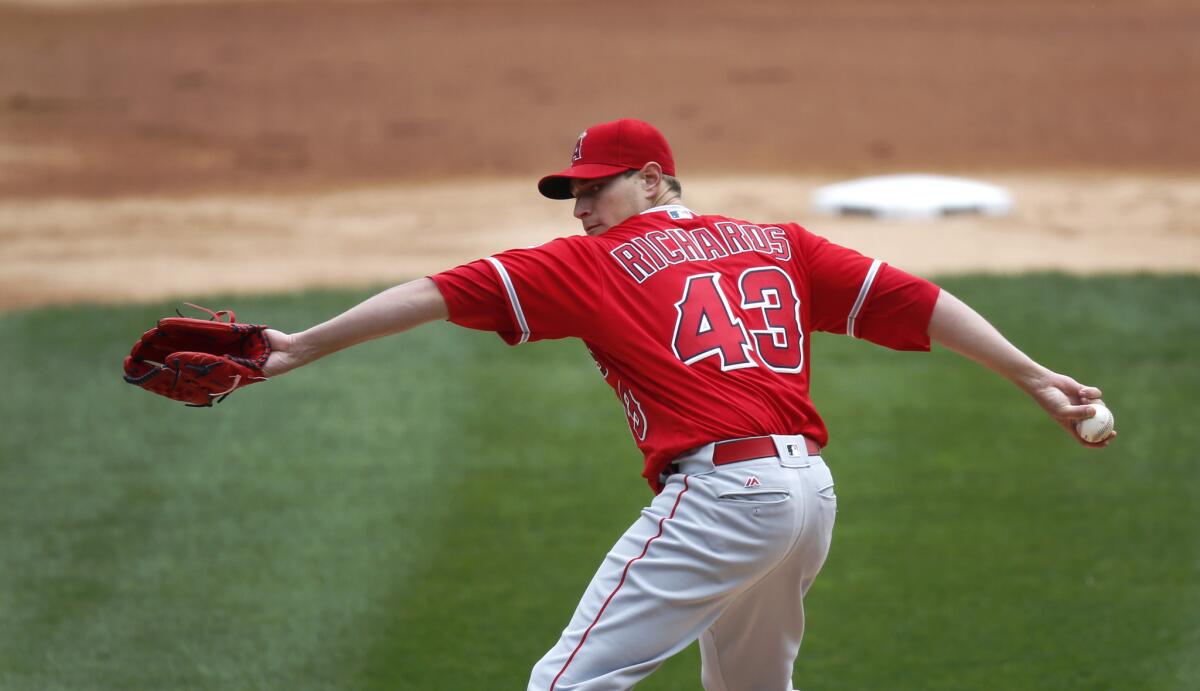Angels mailbag: Questions to follow a tough week for the team

- Share via
That was not a good week for the Angels. They are 13-18 after losing five times in six tries last week. And they also suffered an additional defeat by losing Garrett Richards for the rest of this season and much of next season.
Here’s the place to ask about their future. This weekly feature on Mondays is the forum to get responses to any queries regarding the Angels or any topic at all, submitted through my email (pedro.moura@latimes.com) and Twitter accounts (@pedromoura). Let us get started.
@andrewwhalen: Have you written the Angels’ 2016 autopsy yet? Checked farm system & winter FA class, might want to include 2017 in your report.
With Richards on the shelf with a blown out right elbow and Andrew Heaney’s return this season not a guarantee, it will be exceptionally difficult for the 2016 Angels to qualify for the playoffs. The way I see it, they do not have enough good, healthy players on their roster.
Who is their best starting pitcher? Their rotation later this season figures to include Hector Santiago, Jered Weaver and some combination of Nick Tropeano, Matt Shoemaker, C.J. Wilson, Tyler Skaggs, Nate Smith, Kyle Kendrick and a free-agent signing like Tim Lincecum or Kyle Lohse — more on those guys later. That group is clearly lacking a stopper. Even with Richards, it was bottom-heavy, and now it is exceptionally so.
If they are indeed dead, the cause of the death should not be hard to figure out: The team itself is top-heavy, and the organization as well, as a result of decisions going back many years. We can talk about this later.
@ettinone: What does this do to Richards arb. time? He only had 2 years after 2016 remaining? Does 60-day DL stop it?
It does nothing to it. Richards will still accumulate service time, and he will actually get a raise next season in arbitration, because of the way arbitration works. He will become a free agent after the 2018 World Series.
@SantaCruzDad: Why in the world would Trout stay beyond 2020? My guess is they trade him in his walk year.
You’re assuming here that you or I understand how Mike Trout thinks, which of course is a sizable leap. He is 24, and for the last four years, he has been the best baseball player in the world, despite enormous pressures. He is probably different than you, @SantaCruzDad, and much different than me, for sure.
That’s not to say he will obviously want to stay an Angel, just that we really have no idea. He doesn’t even know, at this point, 4½ years from free agency.
But, to skip ahead: If you are going to plan to trade him during his walk year, why not trade him the off-season before, to obtain more value in return? And if you’re going to trade him then, why not do so earlier, to get even more?
I’ve said for awhile that trading Trout is almost unfathomable. Angels officials have continually said they have absolutely no plans to do so. But, at this point, with the Richards injury that will impact not only 2016 but 2017, I think they should alter their stance some.
Of course they cannot shop Trout, and of course commensurate value is nearly impossible to obtain. Of course there are consequences that could come with any leak of Trout trade conversations. But they are probably not going to win this season or next, and if trading Trout can effectively push some of the remaining 2016 value toward 2018 and beyond, then it starts to make sense.
@jaydieguez: Do they stay in Anaheim?
I believe Occam’s Razor applies here, so, sure.
@bshah79: How many years before Angels are contenders?
That depends on how they approach the coming years. If they do not trade away their better players this season, you can imagine a path to success in 2018, with Trout still 26 and leading the way, Josh Hamilton’s obligations off the books, and a rotation fronted by Richards, Heaney and Skaggs having success. A potential issue: Albert Pujols will be 38 then and will make $27 million. The Angels will pay more than $61 million to Pujols and Trout.
If they do make trades, it depends on the type of return they require. Hector Santiago, Joe Smith and Huston Street are not under contract beyond 2017, and could attract talented prospects in return. Would the Angels ask for more immediate help or be OK with longer-term prospects?
@vpbob2000: The Angels need to make some moves, do you know exactly how far below the tax threshold the team is? Where do you find out?
It is not a publicly available figure, but from what I understand they are something like $5 million below the threshold. It is not confirmed until the winter, as it’s also dependent on earned bonuses their players may make this season.
It does not stand to reason that the tax threshold would hold the Angels back from spending money. If they surpass it this season, they would owe a 17.5% tax on the overage— or about $1 million for every $6 million they spend above the $189-million threshold.
The real power of the tax lies in its compounding. A second straight season of going over requires a 30% payment on the overage, and then 40% the third year and 50% thereafter. But it resets after any season under the threshold, and the threshold is likely to rise next season.
@justknox: Doesn’t Lincecum become a huge priority today?
The Angels are in on Lincecum, from what I understand. He reportedly looked pretty good in his Arizona showcase last week. We will see how much he requires to sign; the previous question may apply here.
The Angels are also in on Kyle Lohse, according to CBSSports.com’s Jon Heyman. For four consecutive seasons, 2011-2014, Lohse was quite good. He fell off dramatically in 2015 and is 37 now, but it’s not crazy to think he could be a better bet than Lincecum.
@JaredKFan: Do you think Mike Butcher may have been partially responsible for Garrett Richards now needing TJ surgery (and possibly Heaney?)
I think that is a very hard thing to say. If you read Jeff Passan’s new book, “The Arm,” which you should do, I think you will come away with the impression that Tommy John surgery is not often the result of one game or one month, or even one season. It is a build-up over time, from these men throwing near-maximum effort for years. Everyone who pitches is susceptible. It is not confined to any specific type of pitcher, or any specific type of delivery. We don’t know when Richards’ ulnar collateral ligament tore, necessitating the Tommy John surgery. We only know that it tore.
One day this spring, I talked with Richards about his days at the University of Oklahoma, when he was used irregularly and generally not treated like a pitcher who’d later approach the precipice of major league stardom. He said it was frustrating, of course. But he also said he was grateful, because the Sooners coaches essentially forced him to “save bullets” at a time when he otherwise would not have.
There is a thought among most major league pitchers that there is a point where each of them will blow out — or require surgery. You can’t pitch and not recognize that, I don’t think.
But, bullets saved and all, Richards still succumbed. One thing is clear, though: an increase in velocity is correlated to an increase in elbow surgeries. Richards throws exceptionally hard. That is obviously not the fault of the Angels’ former pitching coach.
About Heaney, he was throwing across his body when the Angels acquired him from the Marlins. I wrote about that last year. Butcher actually fixed it back to the less-concerning way Heaney had once thrown, according to both parties.
That’s it for this week’s Angels mailbag. Send in your questions to the below addresses at any time, and check back each Monday for answers.
Twitter: @pedromoura
More to Read
Go beyond the scoreboard
Get the latest on L.A.'s teams in the daily Sports Report newsletter.
You may occasionally receive promotional content from the Los Angeles Times.










